Waiving goodbye, we got on the car and started our way back to Graz. That was a rainy day and it had been drizzling never ending since early morning. The sky looked moody and we could only drive slowly. So, we decided to take our time and visit two rural villages.
Less than 30 minutes drive, we arrived at our first destination. Hallstadt sits along the mountain region of Salzkammergut and by the lake of Hallstättersee. The magnificent landscape combines the aspects of cultural and nature in a manner that is both harmonious and mutually complimentary. The history of Hallstadt is significant and can be traced back as far as 5000 BC as results of its rich sources of natural salt, which is still on production now. For that reason, it was named Hallstadt. Hall is the old Celtic name for salt, but some argue that it derived from Old High German. Anyway, active trades had facilitated wealth generation and allowed the evolvement of one of the earliest highly developed culture in Europe, Hallstadt Culture. It existed for a period of 400 years, from 800BC till 400BC. In 1997, it was honored a position in the UNESCO World Cultural Heritage.
Although the weather was not good, the walk along the lake was quite enjoyable. On one side, there was this calm and quite lake. On the other side, there were various skillfully constructed houses made distinct by architectural styles from Gothic, Renaissance, Baroque period up to modern day. Carefully, I hold my umbrella close to me to protect my digital camera, took some photos and headed towards the church.
First thing that struck my mind was that I want to die here. The cemetery’s view was fantastic! * Laugh out loud!* Then, I was surprised by a tradition in the town. Located behind the Catholic Parish Church, there is Beinhaus (Charnel House) on the Romanic ground floor of the Gothic Michaelskapelle. Since 1600, those who were buried in the village cemetery for approximately 10 to 20 years, their bones will be dig out of their grave, cleaned and organised according to the body parts. The skull would then be painted and colored with the details of his or her owners. The recent one was about 30 years ago. Apparently, it was one of the old practices of the Catholic Church. Yikes spooky… Somehow it reminded me of the massacre in Cambodia and the old head hunting tradition of some local aboriginals in east Malaysia. Not wanting to offend the spirits, I quickly prayed and offered my respects.
We then walked to the other end of the village. On the way, I found something fasinating. This thing that look so real, roses. They were displayed nicely in buckets, red, pink, green, purple and yellow. Smelt exactly like roses, but they were just simply soap. Later that we walked in the shop and found they more interesting stuff, soap like chocolate, cheese, piggy, lemon, orange... They all smelt like what they are. Ermmm.... of course not the piggy... The chocolate was extremely tempting and I felt like having a bite. On the other end, were all kind salts mined from this area. Talking about the salt, there were all sort of related tourist traps. As a lot of Japanese visit this region, it was not hard to see special items catered just for them to buy in while... twice folded price...
That non, we had limited time. So without visiting the fully preserved prehistoric miner “Man In Salt”, Hallstadt Salt World, Dachstein Cave, Historical Excavation Site… * Geez… I wished I had more time!* We moved on to Pürgg. This is a mountain village near the border of Styria with two interesting church. Up on the hill to the south stands the little Romanesque chapel of Johanneskapelle with frescos such as, Feeding the Five Thousand and the Birth of Christ dated back 12th Century as interior. Act like a proper tourist, I took few photos, got a postcards, donate some coins and walked down the hill to the Parish Church of St George. A Romanesque church built in 1130 with some fine frescos in the ringing chamber, which had later been remodeled into Gothic style. Here, bones were collected and kept nicely as those at Hallstadt, but the skulls were not painted. Unfortunately, the church was closed for some reasons. Tough luck! We have no choice but to stroll back to the parking. Oh ya! From here, we can get a good view of Grimming. “The tallest mountain in the world…” said the Romans in this region centuries ago.
By the time I reached Graz, it was already 9:00pm and my stomach was groaning badly and I went to get myself a big bowl of Taiwanese Beef Noodle Soup. After few days of local meal, I need my Asian food…
Less than 30 minutes drive, we arrived at our first destination. Hallstadt sits along the mountain region of Salzkammergut and by the lake of Hallstättersee. The magnificent landscape combines the aspects of cultural and nature in a manner that is both harmonious and mutually complimentary. The history of Hallstadt is significant and can be traced back as far as 5000 BC as results of its rich sources of natural salt, which is still on production now. For that reason, it was named Hallstadt. Hall is the old Celtic name for salt, but some argue that it derived from Old High German. Anyway, active trades had facilitated wealth generation and allowed the evolvement of one of the earliest highly developed culture in Europe, Hallstadt Culture. It existed for a period of 400 years, from 800BC till 400BC. In 1997, it was honored a position in the UNESCO World Cultural Heritage.
Although the weather was not good, the walk along the lake was quite enjoyable. On one side, there was this calm and quite lake. On the other side, there were various skillfully constructed houses made distinct by architectural styles from Gothic, Renaissance, Baroque period up to modern day. Carefully, I hold my umbrella close to me to protect my digital camera, took some photos and headed towards the church.
First thing that struck my mind was that I want to die here. The cemetery’s view was fantastic! * Laugh out loud!* Then, I was surprised by a tradition in the town. Located behind the Catholic Parish Church, there is Beinhaus (Charnel House) on the Romanic ground floor of the Gothic Michaelskapelle. Since 1600, those who were buried in the village cemetery for approximately 10 to 20 years, their bones will be dig out of their grave, cleaned and organised according to the body parts. The skull would then be painted and colored with the details of his or her owners. The recent one was about 30 years ago. Apparently, it was one of the old practices of the Catholic Church. Yikes spooky… Somehow it reminded me of the massacre in Cambodia and the old head hunting tradition of some local aboriginals in east Malaysia. Not wanting to offend the spirits, I quickly prayed and offered my respects.
We then walked to the other end of the village. On the way, I found something fasinating. This thing that look so real, roses. They were displayed nicely in buckets, red, pink, green, purple and yellow. Smelt exactly like roses, but they were just simply soap. Later that we walked in the shop and found they more interesting stuff, soap like chocolate, cheese, piggy, lemon, orange... They all smelt like what they are. Ermmm.... of course not the piggy... The chocolate was extremely tempting and I felt like having a bite. On the other end, were all kind salts mined from this area. Talking about the salt, there were all sort of related tourist traps. As a lot of Japanese visit this region, it was not hard to see special items catered just for them to buy in while... twice folded price...
That non, we had limited time. So without visiting the fully preserved prehistoric miner “Man In Salt”, Hallstadt Salt World, Dachstein Cave, Historical Excavation Site… * Geez… I wished I had more time!* We moved on to Pürgg. This is a mountain village near the border of Styria with two interesting church. Up on the hill to the south stands the little Romanesque chapel of Johanneskapelle with frescos such as, Feeding the Five Thousand and the Birth of Christ dated back 12th Century as interior. Act like a proper tourist, I took few photos, got a postcards, donate some coins and walked down the hill to the Parish Church of St George. A Romanesque church built in 1130 with some fine frescos in the ringing chamber, which had later been remodeled into Gothic style. Here, bones were collected and kept nicely as those at Hallstadt, but the skulls were not painted. Unfortunately, the church was closed for some reasons. Tough luck! We have no choice but to stroll back to the parking. Oh ya! From here, we can get a good view of Grimming. “The tallest mountain in the world…” said the Romans in this region centuries ago.
By the time I reached Graz, it was already 9:00pm and my stomach was groaning badly and I went to get myself a big bowl of Taiwanese Beef Noodle Soup. After few days of local meal, I need my Asian food…
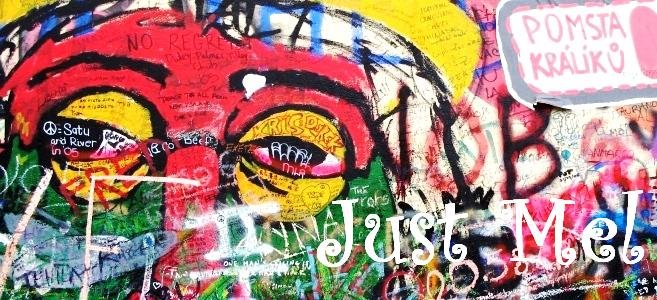
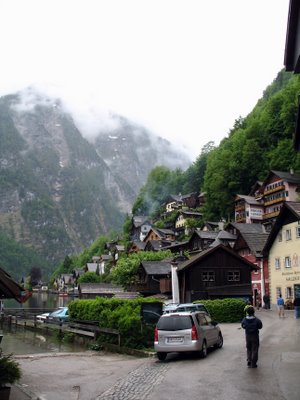


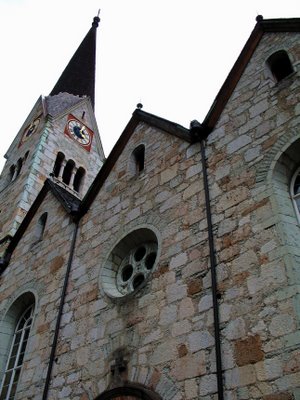

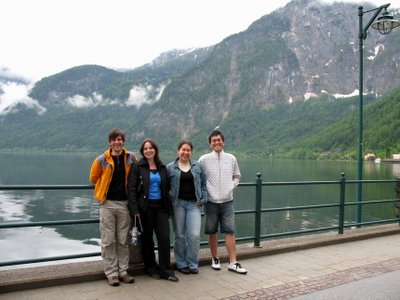


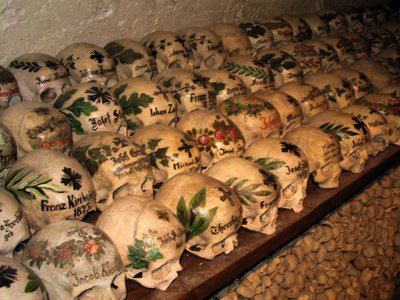









No comments:
Post a Comment